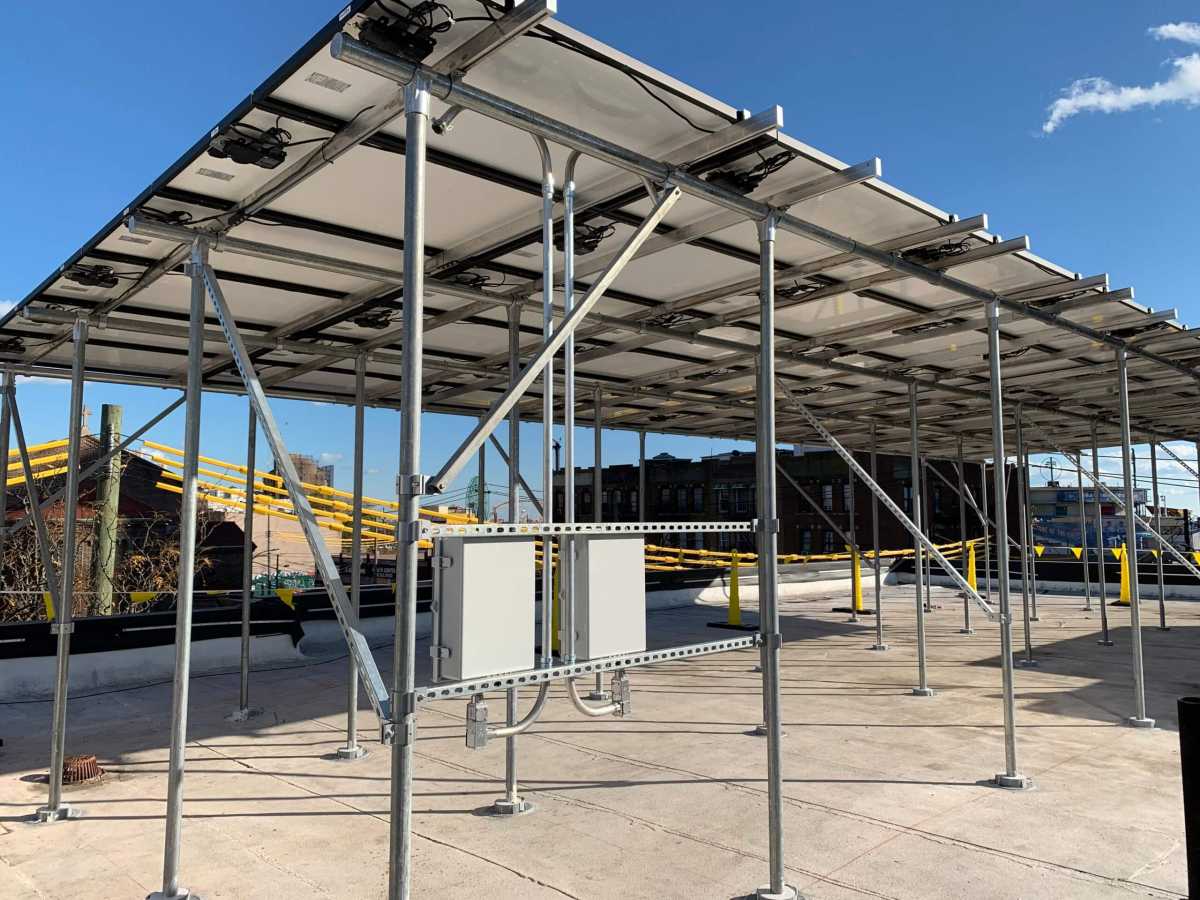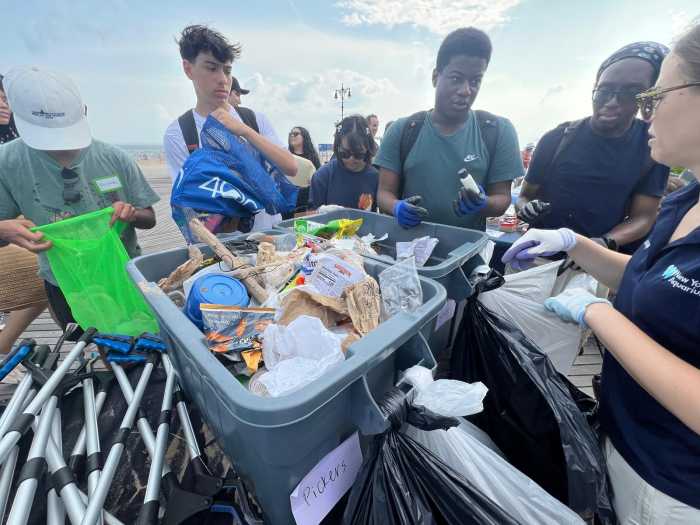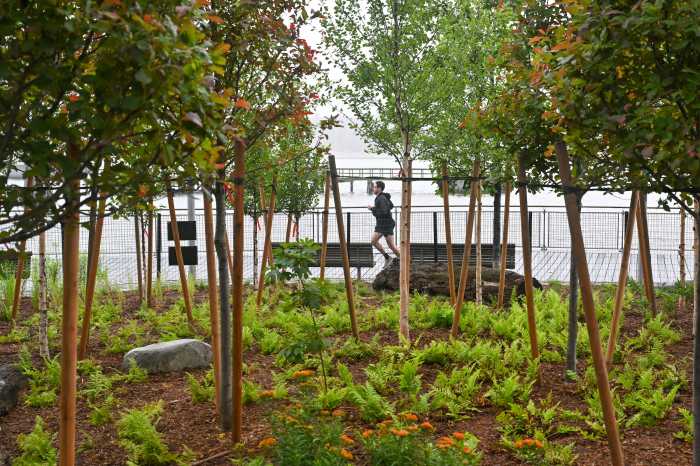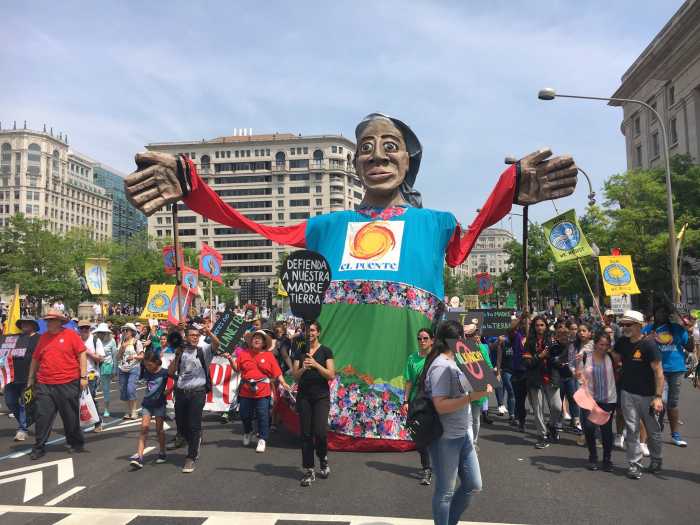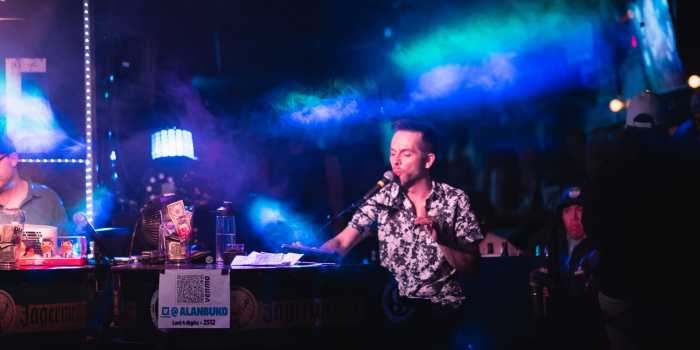The Coney Island Library launched a new solar-powered backup system on Tuesday, which comes as part of a multi-million dollar effort to retrofit southern Brooklyn’s book repositories into storm-resilient disaster hubs.
“We equipped Coney Island library to weather future storms and help the surrounding community weather them,” said Linda Johnson, president and CEO of the Brooklyn Public Library system, at a press conference atop the roof of the library.
Along with the Coney Island branch, three others — Gerritsen Beach, Mill Basin, and the Kings Highway branch in Sheepshead Bay — will see upgrades to provide a community lifeline during future Superstorm Sandy-level weather events.
State officials joined BPL leadership to showcase the 60 solar panels and battery backup system, which will generate renewable energy for the city power system — but, more importantly, keep the library powered during power outages.
The Governor’s Office of Storm Recovery is funding the $4 million project to outfit the four southern Brooklyn library branches, which are all located in flood-prone areas that saw severe damage from Sandy.
The Coney Island branch suffered drastic flooding during the 2012 storm, as waters rose several feet above the building’s ground floor, and extreme rain brought plumes of sand and seawater gushing into the book house.
Subsequent renovations were completed last May after the first phase of the $1.7 million construction project commenced in April 2019.
“The library remains the most versatile and Democratic institution in our city and that’s why it also must be the most resilient,” Johnson said. “When Superstorm Sandy flooded this branch in 2012, we knew that we didn’t just have to build it back, but we had to actually build it back better.”
Meanwhile, the Gerritsen Beach branch reopened after undergoing “massive damage” during the storm the year before and had to be totally renovated as leaks throughout the one-floor library destroyed much of the interior.
Now nearly a decade after the hurricane that rocked the Big Apple, the four libraries will be armed with backup power systems, provided through a partnership between the Governor’s Office of Storm Recovery and SolarOne, which will keep the buildings powered to serve the community as an emergency hub in the event of a storm.
“While these upgrades will certainly strengthen the facilities themselves, they are also an investment in the communities they serve and in all the people who live here,” said RuthAnn Visnauskas, commissioner of the state Division of Housing and Community Renewal. “Access to reliable, renewable and sustainable power will ensure that these buildings have the energy they need to be opened and to shelter or to respond to residents in need during the next emergency whenever that be.”
The solar panels will typically be connected to the city’s power grid, but they will be disconnected in the event of a storm.
The stored power in the backup battery is enough to energize the libraries for a day, and, with enough sunlight, the panels will generate enough energy into the backup battery to use the next day.
Regular library services would be suspended during a hurricane, but the space will instead be open to the public to charge their electronics, warm up from the cold, or utilize an array of emergency services available in the library buildings.
“If our neighbors lose power in their homes they will be able to charge their essential devices in their dry, warm local library,” Johnson said.
The 60 solar panels are raised on a canopy nine feet above the roof, which allowed them to squeeze in as many as possible, and the backup battery — created by Simpliphi — is the first lithium-ion battery installed in New York City, which was chosen because of its safety.
“We did that so we could as many solar panels as possible in here… it’s about 21 kilowatts and it will generate tremendous amounts of renewable energy for this branch of the library,” said Angelica Ramdhari of SolarOne.
She added that the Gerritsen Beach library is the only other branch that would get the same battery which is smaller and more protected against flooding, as those two locations are more vulnerable, but Mill Basin and Kings Highway will utilize larger batteries that will allow for more services.
“This is a pretty small battery prepared to what most community facilities would get and that’s because we are in a really vulnerable area right now so we wanted to make sure we could use that wouldn’t get destroyed by flooding or something else,” Ramdhari said, “but Mill Basin and Kings Highway will have larger batteries so they can support more lighting and other things for the community at the branch.”
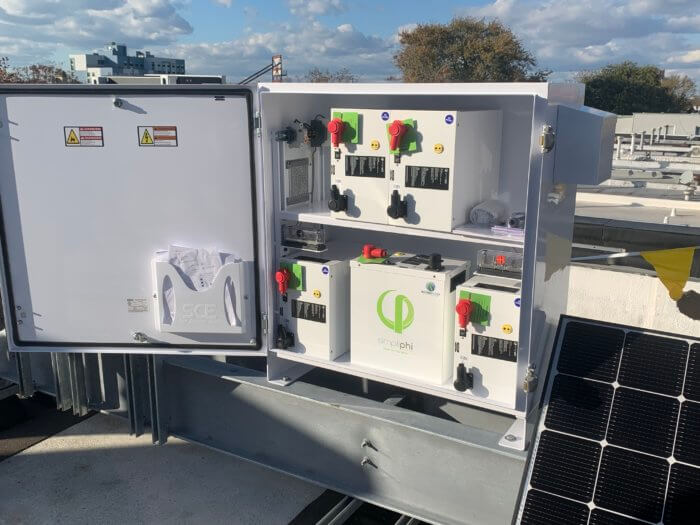
This project is one of a few that are being conducted to reinforce the southern Brooklyn coastline from storm surges, while also developing emergency services for residents during the time of a serious weather event.
And in addition to this project, the Brooklyn Public Library has taken on a number of other initiatives to lower their carbon footprint — having already curbed their emissions by 40 percent — and educate others on the impacts of climate change, the president of the book lender said.
“We are determined to make our libraries and the neighborhoods they serve more resilient and more sustainable,” Johnson said.
The new library infrastructure was presented earlier this year to the community boards whose districts house the libraries — and at a Community Board 18 meeting in February, Assemblymember Jaime Williams questioned why neighboring Canarsie, also a coastal neighborhood, was not considered for the project.
“I just feel as though Canarsie sometimes is put on the back burner,” said the politician who represents a chunk of neighborhoods in southeastern Brooklyn, “and their library should have been included.”
However, Ramdhari said at the meeting that some logistics like lack of sunlight prevented them from using those branches, but that SolarOne was working with another organization to bring renewable energy to that neighborhood.
“We looked at all Brooklyn Public Library sites for the ones that can actually host these systems,” Ramdhari previously said. “The likely thing that happened with the Canarsie branch is that the building was getting too much shade from other buildings or there was some other design constraint that made doing systems there impossible.”
Other community facilities in the borough getting new solar backup systems as part of this initiative include the Block Institute in Gravesend, Kings Bay Youth Organization in Sheepshead Bay, Birch Family Services in Canarsie, Flatland Volunteer Ambulance Corps, and the Gerritsen Beach Volunteer Fire Department.


